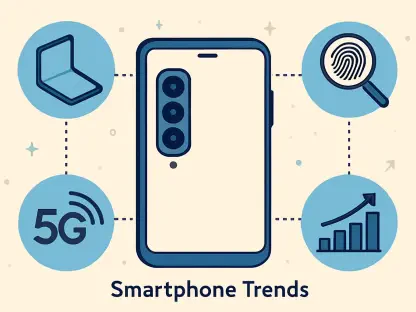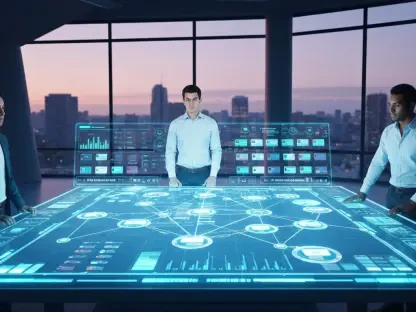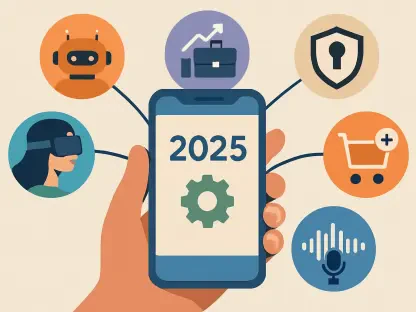Apple Vision Pro marks Apple’s first venture into augmented and virtual reality headsets, entering a new product category since the Apple Watch in 2015. Debuting on February 2, 2024, the Vision Pro is branded as a “spatial computer” and combines digital content with the physical world for a mixed reality experience.
Despite its sophisticated features and cutting-edge technology, the Vision Pro’s $3,500 price point raises the question: Is it worth the investment? In this article, we’ll explore the various aspects of the Vision Pro, from its design and functionality to user experiences and expert reviews, to help you make an informed decision.
An Overview of Vision Pro
Breaking into New Territories
The Vision Pro is not just a new product; it represents Apple’s most ambitious attempt in mixed reality, blending augmented reality (AR) and virtual reality (VR) to create a layered interactive experience. This marks a significant leap for Apple, as it aims to integrate more seamlessly into users’ everyday lives with technology that transcends traditional computing paradigms. The Vision Pro is equipped with advanced capabilities that allow users to interact with digital content in ways previously only imagined. By overlaying augmented content into the real world, it provides both practical and immersive experiences that could potentially revolutionize various industries, including gaming, education, and professional workspaces.
Vision Pro’s mixed reality application means users can remain aware of their physical surroundings while interacting with virtual elements. This feature is particularly valuable in environments where situational awareness is crucial. The blend of digital and physical ensures that users aren’t completely isolated from their environment, a significant improvement over traditional VR headsets. This hybrid reality approach is expected to open up new avenues in how people work and play, making it a noteworthy contender in the burgeoning AR/VR market. Given Apple’s history of innovation, the Vision Pro could be laying the groundwork for a transformative future in wearable computing.
Technical Marvels
Sporting custom micro-OLED displays offering over 4K resolution for each eye, the Vision Pro delivers stunning visuals. The clarity and sharpness of the displays are significant selling points despite some color limitations and vignetting observed by some reviewers. Apple’s choice of micro-OLED technology means that each pixel is individually lit, resulting in deep blacks and vibrant colors that are essential for an engaging visual experience. The high resolution ensures that users can see fine details, which is critical for applications ranging from virtual design to immersive gaming.
The precise eye-tracking system, which allows users to navigate the interface and select objects simply by looking at them, exemplifies Apple’s commitment to intuitive user experiences. This futuristic control method not only makes interaction feel more natural but also reduces the need for handheld controllers, a common point of inconvenience in other VR systems. Coupled with advanced motion sensors and a suite of cameras that track the user’s hand movements, the Vision Pro creates a seamless bridge between user actions and their virtual consequences, pushing the envelope of what VR and AR technologies can achieve.
Design and Comfort
Visual and Physical Appeal
The Vision Pro, with its ski-goggle aesthetics, features a versatile design meant to fit a variety of face shapes. This flexibility is intended to provide a comfortable user experience, although some early users have reported discomfort during prolonged use. The exterior is crafted with high-quality materials, including a laminated glass front and an aluminum alloy frame, giving it a sleek and premium look. This attention to detail in the design ensures that the Vision Pro not only functions well but also appeals to users who value aesthetics. The fit and finish are what one would expect from an Apple product, exuding both form and function in a balanced manner.
Apple has designed the Vision Pro with a flexible Light Seal to block external light, which ensures immersive viewing without distractions. This component adapts to various face shapes and contours, offering a snug fit that minimizes light leakage. Despite these efforts, user feedback indicates mixed experiences regarding long-term wearability. The device’s weight, which is over 1.3 pounds, has been a point of contention, especially for users who wish to wear it for extended sessions. This has led to Apple providing different band options, like the Solo Knit Band and the Dual Loop Band, with the latter being more effective in distributing weight and enhancing comfort.
Wear and Tear
At over 1.3 pounds, Vision Pro’s weight affects long-term comfort. Apple offers two band options—the Solo Knit Band and the Dual Loop Band—with the latter likely being a better choice for extended wear. The headband’s material and structure contribute significantly to the overall user experience. The Solo Knit Band, while lightweight and breathable, may not provide sufficient support for prolonged use. On the other hand, the Dual Loop Band distributes the headset’s weight more evenly, reducing pressure points and making it a more viable option for users who need extended wearability.
Comfort is crucial, especially since the Vision Pro is designed to be used across various activities, from consuming media and playing games to professional tasks and virtual meetings. Apple’s attention to ergonomic details, such as adjustable straps and cushioned interiors, aims to alleviate some of the discomfort associated with extended use. However, it’s worth noting that the headset’s fit can also impact users’ hair and makeup, which can be an inconvenience for some. Given these factors, potential buyers are encouraged to try the headset in a store to ensure it meets their comfort needs before making a significant investment.
Usability and User Experience
General Usage
The Vision Pro stands out in specific scenarios like watching movies or working with multiple apps and windows simultaneously. However, its integration into daily workflows is hindered by the limited availability of optimized apps and games. For entertainment purposes, the high-resolution displays and spatial audio capabilities create a cinematic experience that rivals traditional home theater setups. Users can position multiple windows and apps in mid-air, facilitating multitasking in a way that no other device currently offers. This is particularly beneficial for professional use, where the “infinite canvas” allows for more dynamic arrangements of workspaces.
Despite its versatility, the Vision Pro’s potential is somewhat hampered by the current lack of extensive third-party support. Many popular productivity and entertainment apps have yet to be optimized for the headset, limiting its functional scope. This gap may narrow as more developers take interest in the platform, but for now, it remains a primary consideration for prospective buyers. Additionally, the Vision Pro’s need for a strong internet connection and compatible external devices, like Bluetooth keyboards and mice, for thorough use may present hurdles for seamless daily integration.
Control Mechanisms
The device’s gesture-based control system has received mixed reviews. While intuitive for some actions, the responsiveness and comfort of gestures and eye tracking have room for improvement. The system relies heavily on hand movements and visual indicators to interact with the virtual environment, which can occasionally lead to fatigue, especially during extended sessions. In theory, the gesture controls are designed to be more ergonomic than traditional input methods, but users have reported inconsistencies in tracking precision and occasional lag in execution.
The eye-tracking feature, intended to revolutionize navigation by allowing users to point and click with their gaze, is a standout innovation, yet it has its criticisms. Some users find this method distracting and less precise than advertised, especially in environments with varying light conditions. The in-air keyboard, another innovative feature, has also faced criticism for impracticality during heavy typing. Despite these challenges, the Vision Pro’s control mechanisms represent a progressive step towards more natural and immersive interaction in AR and VR settings, suggesting that iterative improvements could significantly enhance usability.
Audio and Soundscapes
Vision Pro’s audio capabilities are highlighted through spatial audio support and dual-driver audio pods. The audio experience is further enhanced by the ability to adapt sound based on room acoustics. This feature ensures that users get an immersive auditory experience that is both rich and dynamic. The spatial audio technology mimics the way sounds are perceived in the real world, allowing users to detect the direction and distance of audio sources within the virtual environment. This ability to create a three-dimensional soundscape adds another layer to the immersive experience, making activities such as gaming, watching movies, or attending virtual meetings more engaging.
Moreover, Vision Pro is equipped with six microphones that facilitate clear voice commands and calls, enhancing the overall communication experience. The integration with AirPods for even more enhanced audio performance is a thoughtful addition for those who have already invested in Apple’s ecosystem. This attention to audio quality aligns with Apple’s broader efforts to create holistic, immersive experiences across its product lineup. Taken together, these audio features significantly contribute to the headset’s appeal, although their success ultimately depends on the quality of the content being consumed and the user’s specific audio preferences.
Performance and Capacity
Processing Power
The Vision Pro is powered by two main silicon chips, the M2 and R1, which manage general processing and sensor input, respectively. The harmonious operation of these chips ensures a smooth user experience. The M2 chip handles complex computations, powering the visionOS operating system and running demanding applications without latency. In contrast, the R1 chip processes the myriad sensor inputs from cameras, microphones, and motion detectors in real-time, ensuring that the mixed reality environment remains responsive and fluid. This dual-chip architecture allows the Vision Pro to deliver high performance without compromising on battery efficiency or heat management.
This setup enables the Vision Pro to manage multiple tasks simultaneously, from rendering high-definition visuals to processing real-time user inputs, providing an uninterrupted and immersive experience. Early reviews suggest that the Vision Pro’s processing capabilities are robust enough to handle demanding tasks like 3D modeling and video editing, albeit within the constraints of its interface and control systems. Future software updates and third-party app development are likely to further exploit the capabilities of both chips, expanding the range of applications and enhancing overall performance.
Battery Longevity
The Vision Pro’s external battery pack offers up to 2.5 hours of use, which is suitable for short immersive experiences. Users can also operate the device all day by keeping it plugged in. While 2.5 hours might suffice for watching movies or short gaming sessions, it falls short for extended work periods or long virtual meetings. The external battery pack connects via a braided cable, designed for durability and minimal interruption. However, the necessity of an attached battery pack can be seen as an inconvenience, especially when compared to more lightweight wearables.
For those requiring longer use, keeping the Vision Pro plugged in ensures uninterrupted operation, though this does tether the user to a power source, limiting mobility. Battery life is an area where subsequent iterations of the device could see significant improvements, especially as advancements in battery technology and power efficiency become available. The balance between performance and power consumption is a delicate one, and Apple’s approach to offering both portable and all-day-use options reflects an understanding of varied user needs. However, as it stands, battery longevity remains a consideration for potential buyers who anticipate extensive use.
Medical and Health Considerations
The decision to undergo any medical procedure should be made after careful consideration of the potential benefits and risks. Prior to making such decisions, consulting with a healthcare professional is essential to ensure one is fully informed about their options.
Health Warnings
Potential buyers with medical conditions like heart issues or migraines should consult with healthcare professionals before using the Vision Pro, as the device could aggravate certain conditions, making medical advice essential. This is especially important given the immersive nature of the Vision Pro, which can significantly impact the user’s sensory perceptions. The visual and motion stimuli involved in using AR/VR technology can affect individuals differently, with some experiencing discomfort or exacerbation of existing medical conditions. Therefore, a preemptive consultation with a healthcare provider can help identify any potential risks.
Moreover, Apple’s own guidelines indicate that users with conditions such as vertigo, epilepsy, or severe motion sickness should exercise caution. The high level of sensory engagement and the need for intensive focus can lead to disorientation, dizziness, or even nausea for some users. This makes it paramount to understand personal health limitations before committing to extended use of the Vision Pro. Apple has incorporated safety features like quick access to a vision field outside the headset, but users should be aware of the potential health impacts and use the device in a controlled, responsible manner.
Safety Precautions
Pregnant users and individuals prone to nausea or vertigo must exercise caution, as the immersive nature of the headset could trigger these symptoms more frequently. The sensory overload from continuous use of the Vision Pro might lead to more pronounced effects in pregnant individuals or those with a history of motion sickness. Given the complex interplay of visual, auditory, and motion inputs in mixed reality environments, it is vital for users to be mindful of their well-being. Taking regular breaks and gradually acclimating to prolonged sessions can mitigate some of these symptoms.
Additionally, some users may experience eye strain or fatigue due to extended use, as the eyes are constantly adjusting to the mixed reality inputs. To alleviate this, it is recommended to follow the 20-20-20 rule: take a 20-second break to look at something 20 feet away every 20 minutes. Furthermore, adjusting the fit and comfort of the headset can help reduce physical discomfort. Ensuring proper calibration and fit can prevent unnecessary strain on the neck and shoulders, providing a more sustainable experience. By observing these precautions and listening to one’s body, users can make their Vision Pro experience both enjoyable and safe.
Mixed Reviews and Opinions
Praise and Criticism
Reviewers commend the Vision Pro for its advanced technology but criticize its practical usability and the physical comfort of long-term wear. The technological advancements, such as high-resolution displays, sophisticated eye-tracking, and robust processing power, have garnered praise for setting a new benchmark in the AR/VR space. The intuitive integration of Apple’s ecosystem also adds an element of convenience for users already embedded in its product family. However, these innovations are somewhat overshadowed by the challenges associated with prolonged use and the current lack of third-party applications optimized for the platform.
Critics highlight that while the Vision Pro showcases Apple’s technical prowess, practical issues such as weight, comfort, and limited software support prevent it from being a must-have device at this stage. The high price point further exacerbates this perception, as consumers expect a device that offers both breakthrough technology and day-to-day practicality. This dichotomy between innovation and usability underscores the early-stage nature of the Vision Pro. As such, it resonates more with early adopters and tech enthusiasts than with the average consumer looking for a seamless integration of new technology into their daily routines.
Isolating Experience
The immersive nature can be isolating, setting it apart from the more externally focused experience provided by devices like the Mac. While the Vision Pro allows for unparalleled engagement with virtual content, the level of immersion often comes at the cost of disconnecting from the physical environment. This isolation can affect social interactions and awareness of real-world surroundings, posing a potential drawback for those who value staying connected with their environment even while using advanced technology. The device’s capability to transition between augmented reality and full virtual reality modes offers some flexibility, yet the isolating nature in its most immersive settings remains a point of contention.
Users have noted that the Vision Pro creates an “in there” experience, which contrasts sharply with the “out there” interaction models of traditional devices. This can be particularly challenging in social environments where users might need to split their attention between the virtual and physical worlds. Although features like the “EyeSight” display aim to bridge this gap by showing others when a user is engaged in augmented versus immersive modes, the effectiveness of these interactions still falls short of maintaining a balanced real-world presence. Therefore, the isolating nature of the Vision Pro should be a significant consideration for potential users who prioritize a balanced interaction with their surroundings.
Realistic or Not
The external EyeSight display and digital Personas face criticism for portraying unrealistically blurry images of the user’s eyes, detracting from the immersive experience. The EyeSight feature, which projects images of the user’s eyes on an external display to show engagement, aims to create a sense of connection with those around. However, the execution has been criticized for not entirely capturing the nuanced expressions and clarity needed for genuine interaction. The digital Personas, while innovative, also fall short in delivering realistic and dynamic representations, often appearing unnatural and somewhat disconcerting.
These shortcomings highlight the ongoing challenge in achieving true-to-life representations in mixed reality environments. Despite the advanced technology underpinning the Vision Pro, aspects like EyeSight and digital Personas seem to be in their nascent stages, requiring further development to fully meet user expectations. The feedback underscores the importance of continuous improvement in areas that directly affect user experience and interaction. Future iterations will need to address these concerns to enhance the realism and engagement levels, ensuring that the Vision Pro not only impresses with its capabilities but also delivers on its promise of seamless integration into both virtual and physical realms.
Future Prospects
What Lies Ahead
Rumors of future versions include a more affordable option with lower-end components and an advanced version potentially boasting an M5 chip and 5G connectivity. These developments suggest that Apple is keen on expanding the Vision Pro’s reach by catering to different market segments. A less expensive version could make the technology more accessible to a broader audience, fostering wider adoption and encouraging developer interest in creating more applications suited to the platform. On the other hand, a high-end model with cutting-edge features might appeal to professionals and enthusiasts looking for the best performance and innovations.
The introduction of 5G connectivity would be particularly transformative, enabling real-time data transmission and significantly enhancing the immersive experience. This could open new possibilities in fields such as remote collaboration, virtual tourism, and interactive education, making the Vision Pro a versatile tool across various industries. While the exact specifications and launch timelines for these future versions remain speculative, the direction indicates a commitment to refining and diversifying the product line, ultimately aiming to solidify Apple’s position in the mixed reality market.
Improved Iterations
The Vision Pro is undoubtedly impressive for a first-generation product. Future iterations are expected to address current limitations, enhance comfort, and expand the application range, shaping the future of spatial computing and mixed reality. Anticipated improvements could include lighter weight, better battery life, and more ergonomic designs to increase long-term comfort. Software advancements, driven by an expanding ecosystem of developers, are likely to offer a more robust range of applications and functionalities, further integrating the Vision Pro into everyday use cases.
As Apple continues to refine the Vision Pro, user feedback will play a crucial role in guiding these enhancements. The evolving landscape of AR and VR technology suggests that iterative advancements will build upon the solid foundation laid by the Vision Pro, making future versions more user-friendly and versatile. This progression will not only improve the device’s utility and appeal but also contribute to the broader acceptance and integration of spatial computing into mainstream tech usage. With each new iteration, Apple’s commitment to innovation and excellence is expected to bring the Vision Pro closer to becoming an indispensable tool in both professional and personal settings.
Conclusion
Apple Vision Pro represents Apple’s initial foray into the realm of augmented and virtual reality headsets, introducing a new product line since the Apple Watch was released in 2015. Slated to launch on February 2, 2024, the Vision Pro is described as a “spatial computer,” merging digital content with the physical world and offering a unique mixed reality experience.
Despite its state-of-the-art features and advanced technology, the Vision Pro’s steep price of $3,500 prompts a significant debate: Is it worth the hefty investment? In this article, we aim to delve deep into the various facets of the Vision Pro. We’ll examine its design, functionality, user experiences, and insights from industry experts to aid you in making an informed choice.
From its sleek design intended to be both futuristic and user-friendly to the seamless integration of digital and physical elements, the Vision Pro promises a revolutionary way to interact with technology. Reviews from early users and tech experts highlight both its groundbreaking capabilities and some challenges. Our thorough analysis will offer a comprehensive overview of whether the Vision Pro is a savvy investment for you.









